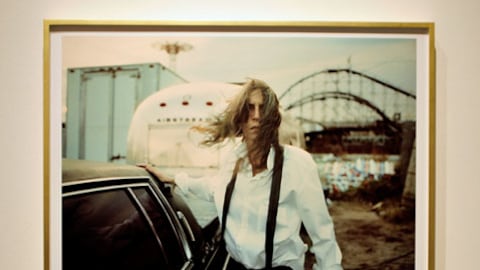“I haven’t brushed my teeth,” Patti Smith says right after we are introduced. It feels more like a peace offering than a warning, a casual gesture signifying her candidness. The rocker/poet/artist had been cruising around the Robert Miller Gallery in Chelsea, tweaking and nudging the installation and sculptural elements included in her joint exhibition with photographer Steven Sebring (on view through February 6).
Smith—sporting blue jeans, combat boots, a black blazer, and that signature mess of stringy brown hair—offers to show me around. She leads me into the first room of the exhibition. The smell of lavender wafts through the air.
Click Image to View Our Gallery of Work by Patti Smith and Steven Sebring

“It’s lavender, mint, and sage,” Smith says. She explains that she adorned the sculpture with aromatic shrouds and satchels of herbs to “invest a sense of poetry and the elements” into the piece, “of different feelings—anger, sorrow, ecstasy…”
The work is also emblematic of Smith’s longtime infatuation with French poet Arthur Rimbaud, whom, she notes, was in Ethiopia when he developed gangrene in his right knee. Too weak to walk, the poet instructed locals in building this very contraption to get him to the hospital. He returned to France for treatment and died shortly thereafter.
Before we move on, Smith points to a small black-and-white Polaroid of an unmade mattress. “Here’s another death bed—or life bed, really,” she says. “I took this right after [poet and The Basketball Diaries author] Jim Carroll died last year.”
Click Image to Watch the Trailer for Steven Sebring's Dream of Life
Memorials seem to permeate every corner of this show—memorials for times past, for the loved, for the admired, and even for the wholly unknown. Titled Objects of Life, the exhibition is tied to Sebring’s recent documentary, Dream of Life, for which he trailed Smith both at home and on the road for almost 15 years. Sebring’s contributions include elegant, large-scale color photographs of Smith’s prized possessions (a Gibson guitar named Bo, a striped yellow dress she wore as a child) but the real heart here comes from the ever-prolific Smith herself.
“Hanging a show like this is always the hardest part,” she says. “Some work is magnified by other work, but I don’t really know how anything works. I just keep working…”
As Smith walks through the gallery, we pass her surprisingly adept post-9/11 series—quiet abstractions that incorporate silk screens of those now-infamous grates, protruding like shards of glass from the settling disaster site. She also points out some of her personal affects: a typewriter, books like Mabel Dodge Holmes’ Joan of Arc, and a Polaroid camera, all displayed on a short pedestal as art objects in themselves. She doesn’t miss these items nearly as much as she misses her bedroom chair, which is installed around the corner and covered with a white sheet.
Smith then enters a room devoted to her close friendship with photographer Robert Mapplethorpe. Glass vitrines are filled with Mapplethorpe’s belongings (a marble cross, those famous velvet slippers), Smith’s letters to the artist (both before and after his death), and a picture of the two of them dressed to the beatnik nines at Coney Island. It’s an exhibition within an exhibition that accompanies Just Kids, Smith’s forthcoming memoir recalling her early years with Mapplethorpe in New York City as well as their touching reliance on each other, both for survival and to spark creative output. Smith starts at the beginning—the child she gave up for adoption at age 20, the Rimbaud book she stole before moving to New York, nights spent sleeping in Washington Square Park, her serendipitous run-in with Mapplethorpe at an uptown bookstore.
In the book, Smith details how she and Mapplethorpe tried in earnest to build a life together—“As if it was the most natural thing in the world, we stayed together,” she writes, “not leaving each other’s side save to go to work. Nothing was spoken; it was just mutually understood.” They shared an apartment in Brooklyn (a former drug den, it seems) for $65 a month, they traded off breadwinning duties as neither was particularly great and holding down a job, and they entertained themselves for hours, drawing pictures of muscled Michelangelo sculptures and listening to the same Tim Hardin and Joan Baez records over and over again. There was some time apart (Mapplethorpe lived in San Francisco for a while where he was able to come to terms with his homosexuality and massive Catholic guilt), but eventually and, after someone was murdered in their Brooklyn building, the two made the move to the historic Chelsea Hotel—where Mapplethorpe finally picked up a camera and Smith realized that she belonged on stage.
Having her personal life on display—both in print and in the gallery—doesn’t much bother her. “It’s what I do,” she says. “Your art is your personal life.
She pauses for a few seconds before continuing. Folks were lining up at the door in anticipation of the show’s 6 p.m. opening party (where Michael Stipe, Terry Richardson, Jessica Lange, Sam Shepard, and Calvin Klein later made the scene).
“The problem is you get attached to the work you do. It’s hard to let go of it—like children.”
Plus: Check out Art Beast for galleries, interviews with artists, and photos from the hottest parties.
Rachel Wolff is a New York-based writer and editor who has covered art for New York, ARTnews, and Manhattan.






